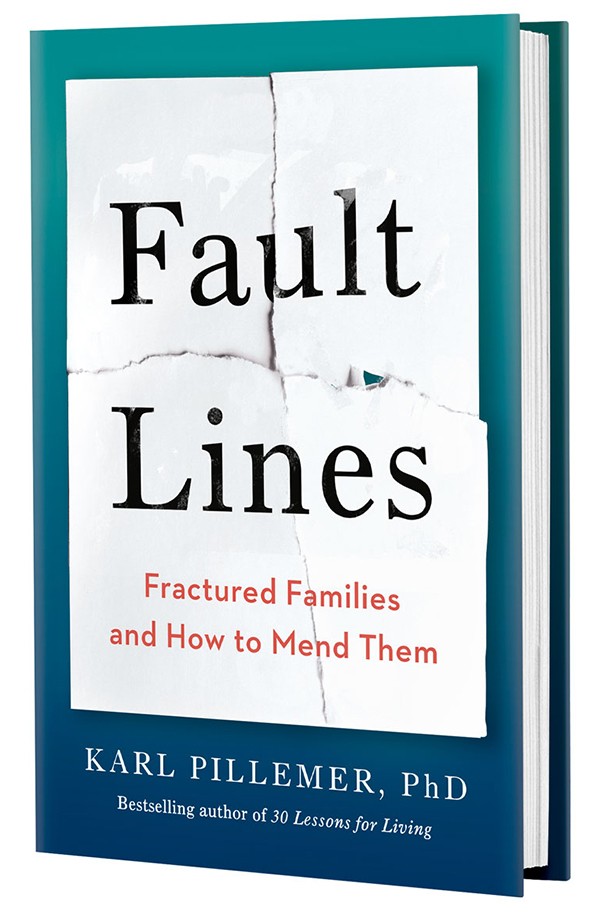Cornell University sociologist Karl Pillemer discusses the stigma of estrangement and steps to reconciliation as he launches his newest book, “Fault Lines: Fractured Families and How to Mend Them.”
Pillemer: Family estrangement a problem ‘hiding in plain sight’
By James Dean
Though she appeared successful and fulfilled, Kristine Freeman privately suffered from a painful secret: Her parents had rejected her after a divorce they disapproved of, initiating a long-term estrangement. Cut off from day-to-day family interactions and holiday gatherings, Freeman (a pseudonym) felt utterly alone.
“I was on my own in dealing with it,” Freeman told Karl Pillemer, the Hazel E. Reed Professor in the College of Human Ecology’s Department of Human Development. “That’s where a lot of the fear of judgment and embarrassment came from, because I didn’t know how prevalent estrangement was.”
Pillemer’s new book, “Fault Lines: Fractured Families and How to Mend Them,” published Sept. 8, documents the surprising prevalence of estrangement for the first time. Conducting the first large-scale national survey on the subject, Pillemer found that 27% of Americans 18 and older had cut off contact with a family member, most of whom reported that they were upset by such a rift. That translates to at least 67 million people nationally – likely an underestimate, Pillemer said, since some are reluctant to acknowledge the problem.
“It became clear that estrangement is a very widespread problem that was hiding in plain sight,” said Pillemer, who is also a professor of gerontology in medicine at Weill Cornell Medicine. “I felt it was critically important to bring this problem out of the shadows and into the clear light of open discussion and dialogue.”
Of the more than 1,300 people Pillemer surveyed, 10% reported being estranged from a parent or child, 8% from a sibling and 9% from extended family members including cousins, aunts and uncles, grandparents, nieces and nephews.
In addition to these national survey findings, the book shares insights from the Cornell Family Reconciliation Project’s in-depth interviews with 200 people who have experienced it, and another 100 who achieved reconciliations. Pillemer draws upon the latter group to provide practical tips and strategies for how to build bridges over family rifts, a process that he writes can become “an engine for personal growth.”
Pathways to estrangement vary, Pillemer said, but often are linked to early experiences with harsh parenting, parental favoritism and parental divorce. Other common triggers of family rifts include tensions with in-laws; disputes over money, inheritances and business deals; and value differences and unrealistic expectations.
Each situation, Pillemer said, involves a breakdown of family bonds, typically coupled with poor and increasingly hostile communication. Long-simmering feuds may culminate in a “volcanic event” in which one family member declares “I’m done” with another.
Pillemer concluded that family estrangements, the focus of little academic research to date, may be understood as a form of chronic stress that results from broken attachment bonds, the pain of social rejection and constant uncertainty about the status of the relationship.
Estrangements may generate “collateral damage,” Pillemer said, forcing families to take sides and rippling across multiple generations. It can cut off family members from financial and social resources that might otherwise prove valuable.
Even in a more fluid and less structured society, Pillemer said, estrangement still matters profoundly.
“I learned that people who are estranged from a family member feel deep sadness, long for reconnection and wish that they could turn back the clock and act differently to prevent the rift,” he writes.
Those feelings might not exist in extreme cases involving violence or abuse, Pillemer said, but his research led him to believe that in most cases reconciliation is possible and worth pursuing.
Among those who were able to reconcile, Pillemer said, almost all employed one strategy: They abandoned a need for the estranged relative to accept their version of the past and to apologize. They instead focused on the present and future of the relationship, adopting more realistic expectations about the other person rather than trying to change them.
Reconcilers came to understand, or at least considered, what role they played in the conflict, seeing it as a dynamic, two-way process. That didn’t necessarily mean accepting fault, Pillemer said, but engaging in self-examination about their level of responsibility.
Other helpful strategies included talking with relatives who had not taken their side, journaling – including writing narratives from the estranged relative’s perspective – and seeking counseling individually or with the relative, when possible.
Performing a sort of return-on-investment calculation, reconciled family members determined the minimum relationship they could live with to, for example, enable a relationship between grandkids and grandparents. Even unsuccessful attempts to reconcile sometimes led to greater peace of mind.
“Most eventually felt much better after the reconciliation, even if it wasn’t perfect,” Pillemer said. “There was a sense that it might be difficult, but they weren’t carrying that backpack around anymore, they weren’t carrying that weight on their shoulders.”
Media Contact
Get Cornell news delivered right to your inbox.
Subscribe

